
Anemia is a genus of ferns. It is the only genus in the family Anemiaceae in the Pteridophyte Phylogeny Group classification of 2016. Alternatively, the genus may be placed as the only genus in the subfamily Anemioideae of a more broadly defined family Schizaeaceae, the family placement used in Plants of the World Online as of November 2019. Its species are sometimes called flowering ferns, but this term is more commonly applied to ferns of the genus Osmunda. Fronds are dimorphic; in fertile fronds, the two lowermost pinnae are highly modified to bear the sporangia.

Pteris (brake) is a genus of about 300 species of ferns in the subfamily Pteridoideae of the family Pteridaceae. They are native to tropical and subtropical regions, southward to New Zealand, Australia, and South Africa, north to Japan and North America. 78 species are found in China. Some species of Pteris have considerable economic and ecological value, such as Pteris multifida, Pteris ensiformis, Pteris vittata can be used for ornamental purposes; as a hyperaccumulator, Pteris multifida and Pteris vittata can be used to control soil pollution.
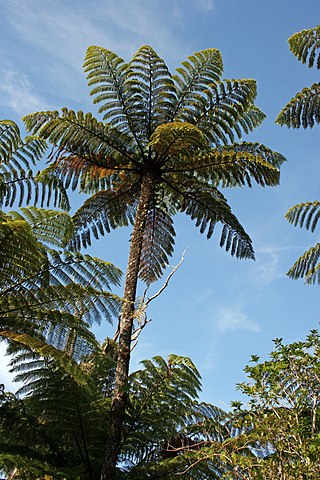
Cyathea is a genus of tree ferns, the type genus of the fern order Cyatheales.
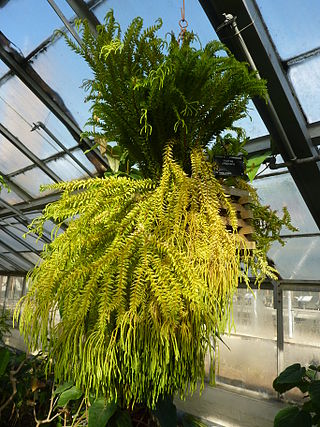
Phlegmariurus is a genus of lycophyte plants in the family Lycopodiaceae. The genus is recognized in the Pteridophyte Phylogeny Group classification of 2016, but not by some other sources, which keep it in a broadly defined Huperzia.

Sphaeropteris is a genus of tree fern in the family Cyatheaceae. It has been treated as a subgenus within the genus Cyathea, but is accepted in the Pteridophyte Phylogeny Group classification of 2016.

Alsophila is a genus of tree ferns in the family Cyatheaceae. It has also been considered to be a section in the subgenus Cyathea of the genus Cyathea.

Pleopeltis is a genus of ferns in the family Polypodiaceae, subfamily Polypodioideae, according to the Pteridophyte Phylogeny Group classification of 2016 (PPG I). The genus widely distributed in tropical regions of the world, and also north into temperate regions in eastern North America and eastern Asia. Several species are known by the common name scaly polypody and resurrection fern.
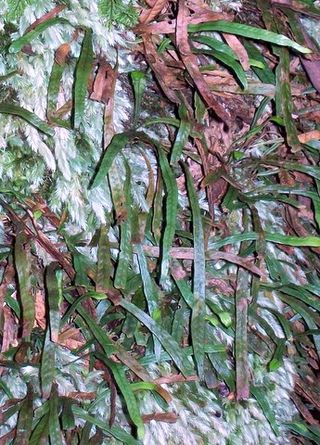
Grammitis is a genus of ferns in the family Polypodiaceae, subfamily Grammitidoideae, according to the Pteridophyte Phylogeny Group classification of 2016 (PPG I). It had formerly been placed in the family Grammitidaceae, but this family is no longer recognized by most authors because phylogenetic analyses of DNA sequences have shown that it is embedded in Polypodiaceae.

Hymenophyllum is a genus of ferns in the family Hymenophyllaceae. Its name means "membranous leaf", referring to the very thin translucent tissue of the fronds, which gives rise to the common name filmy fern for this and other thin-leaved ferns. The leaves are generally only one cell thick and lack stomata, making them vulnerable to desiccation. Consequently, they are found only in very humid areas, such as in moist forests and among sheltered rocks. They are small and easy to overlook.

Lastreopsis, known as shieldfern, is a genus of ferns in the family Dryopteridaceae, subfamily Elaphoglossoideae, in the Pteridophyte Phylogeny Group classification of 2016.

Tectaria is a genus of fern in the family Tectariaceae, according to the Pteridophyte Phylogeny Group classification of 2016. Halberd fern is a common name for species in this genus.

Hypolepis (beadfern) is a genus of ferns described as a genus in 1806. The word is derived from Greek, meaning "under scale". It is found in tropical and subtropical regions, primarily in the New World but also in the Old World and on various oceanic islands.
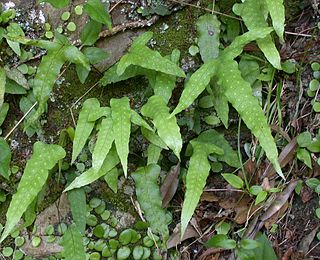
Selliguea is a fern genus in the family Polypodiaceae. The type species is Selliguea feei.

Lellingeria is a genus of ferns in the family Polypodiaceae, subfamily Grammitidoideae, according to the Pteridophyte Phylogeny Group classification of 2016 (PPG I).
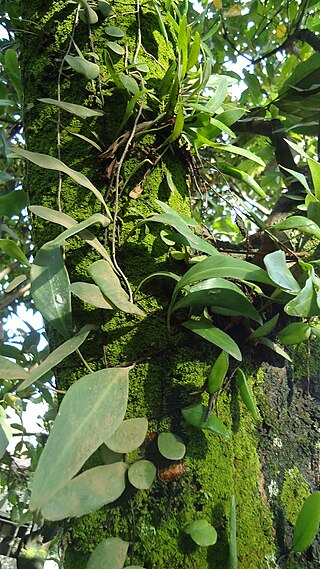
Pyrrosia is a genus of about 100 fern species in the polypod family, Polypodiaceae. Like other species in Polypodiaceae, the species of Pyrrosia are generally epiphytic on trees or rocks, a few species are terrestrial. The Latin name of Pyrrosia comes from the Greek pyrrhos (red), which refers to its leaves that are red due to the sporangia.
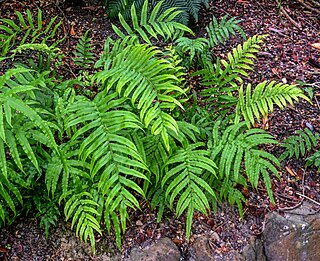
Parablechnum is a genus of ferns in the family Blechnaceae, subfamily Blechnoideae, according to the Pteridophyte Phylogeny Group classification of 2016. The genus is accepted in a 2016 classification of the family Blechnaceae, but other sources sink it into a very broadly defined Blechnum, equivalent to the whole of the PPG I subfamily.

Serpocaulon is a genus of ferns in the family Polypodiaceae, subfamily Polypodioideae, according to the Pteridophyte Phylogeny Group classification of 2016 (PPG I). The genus is native to Northern and Southern America.






















